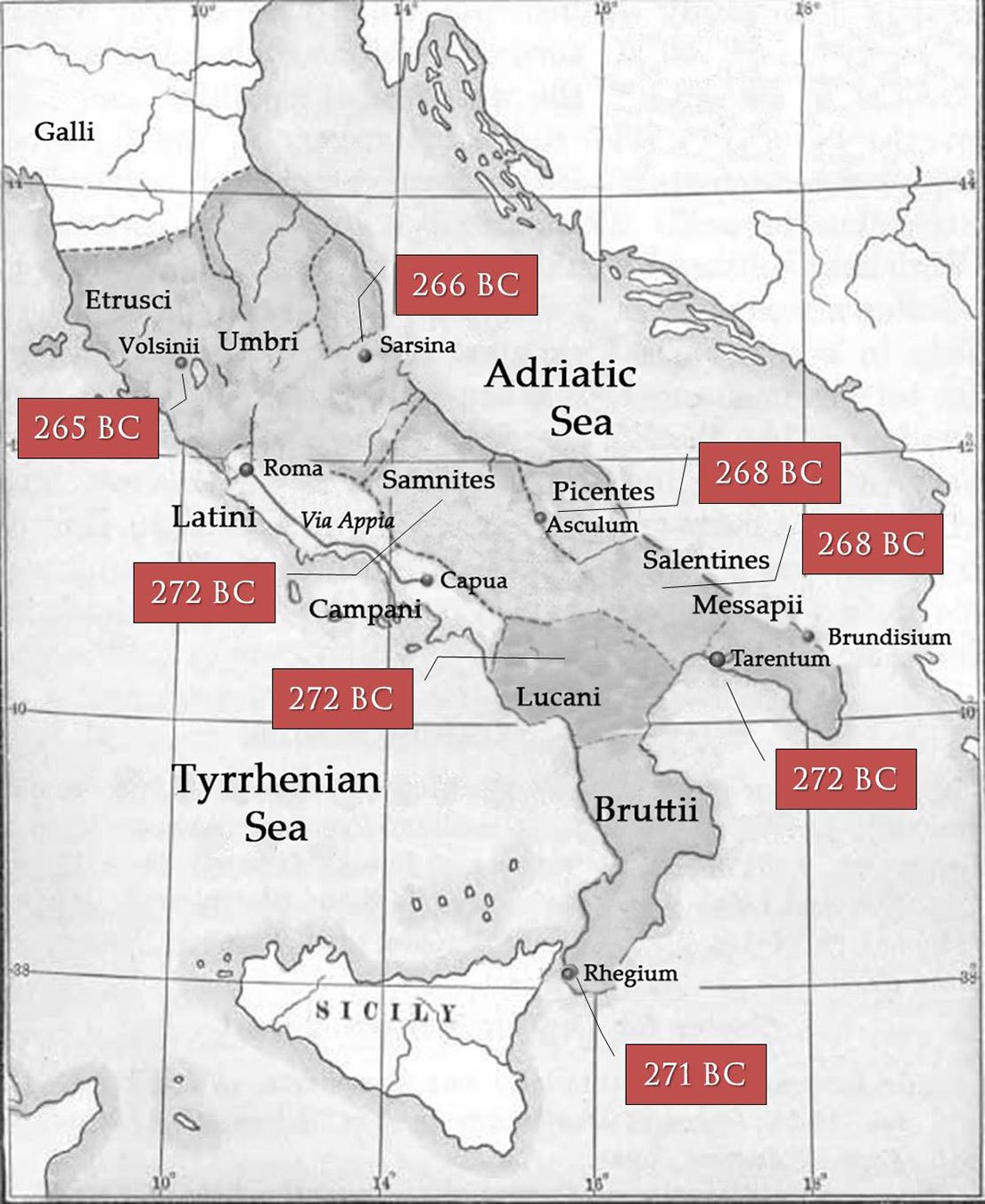272-264 BC
Final Reduction and Political Consolidation of Italy
The departure of Pyrrhus left the cities of Southern Italy to the mercy of Rome. Milo, Pyrrhus’ lieutenant, held the citadel at Tarentum. None of the cities that joined Pyrrhus ceased resisting Roman attempts at hegemony. The Samnites, Lucanians, Bruttians continued guerilla warfare in the mountains.
Extension of Roman Hegemony in Italy after the end of the Pyrrhic War
With the departure of Pyrrhus, the Romans were free to settle matters in Italy. Most of the cities submitted. A few, such as the Samnites and Lucanians, continued to resist by employing guerilla tactics. The map at left shows the year in which a city state or a people submitted to Roman rule.
In 272 BC, L. Papirius Cursor the younger and Sp. Carvilius, who had crushed the Samnites at the end of the 3rd Samnite war, were elected consuls.
Papirius invested Tarentum and in the meantime received submission of the Lucanians and Bruttians.
Carvilius attacked the Samnites and scattered their forces. This concluded the end of the “4th Samnite War”.
Tarentum Surrenders in 272 BC
Tarentum surrendered to Rome in the summer of 272 BC. Papirius entered into a secret agreement with Milo by which Milo would leave the city to the Romans. Milo sailed for Epirus and the aristocratic party seized the government and submitted to Rome.
Conditions of Surrender
Tarentum was allowed its independence but she had to pay an annual tribute, her fortifications were razed, her arsenal dismantled, the fleet surrendered and a Roman garrison was placed in her citadel.
Regium reduced in 271 BC
C. Genucius, a Plebeian consul, was sent to crush Campanian soldiers under the leadership of Decius Vibellius, who had formed a military oligarchy in Rhegium in much the same way as the Mammertines had done just across the straits in Messana. The city was taken and all of the defending soldiers put to the sword. Some of Vibellius’ soldiers were Roman citizens and these were held for trial before the Roman Assembly. They were condemned to be scourged and then beheaded as traitors to the Republic. Regium was restored to its Greek citizens.
Salentines and Messapians Submit to Rome in 268 BC
These people who occupied the heel of Italy surrendered. As a consequence, the city of Brundisium and surrounding lands was ceded to Rome.
Picenians conquered in 268 BC
Picenum, the coastal land between Umbria and the Marrucinians, and their chief city Asculum, were taken by storm. A portion of the population was resettled between Naples and the Silarus.
Umbria reduced in 266 BC
Sarsina, the chief city of the Umbrians, was taken and all of Umbria fell under Roman domination.
Etruria Submits in 265 BC
None of the Etruscan cities could stand up to Rome. Even Volsinii, the strongest, was forced to sue for peace. Volsinii had armed her slaves against Rome. But these revolted and overthrew their masters, introducing a regime even more oppressive than the one that had oppressed them. The aristocracy appealed to Rome for help. The Senate answered their request and invested the city.
Shortly thereafter the city surrendered. The Romans sacked the city, destroyed the old walls and transferred its two-thousand statues and other works of art to Rome. After the fall of Volsinii, all of the Etruscan cities made formal submission.

